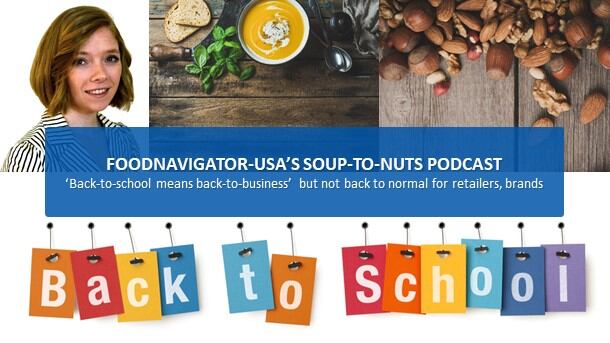That said, in many ways this back-to-school season is unlike others in recent history because it not only carries the excitement of a fresh start and the potential to experience much-missed and anticipated milestones, but it is also weighed down by pandemic-related health, safety and financial concerns.
To better understand how these factors are influencing consumers – including what they are buying, where they are shopping and how they are balancing sometimes conflicting priorities – Julie Companey, director of client strategy for the grocery drug mass channel at the marketing technology and omnichannel solutions firm Valassis joins this episode of FoodNavigator-USA’s Soup-To-Nuts podcast. She shares insights from a survey of 800 parents about their take on back-to-school, what they need and how retailers and brands can help them navigate the season.
[Editor’s note: Never miss an episode of FoodNavigator-USA’s Soup-To-Nuts podcast – subscribe today.]
Back-to-school is not back-to-normal
According to Valassis’ research, this fall is a complete 180 degrees from last year when many regions were locked down and the promise of vaccines were still on the horizon. And while many restrictions have lifted and most districts are welcoming students for in-person classes, Companey notes that this year’s back-to-school season is still far from back-to-normal.
“Last year, most consumers really didn’t have any idea how their children would be educated” with 60% of caregivers unsure how children would be educated, but this year more than 60% believe their children will return to school in-person, she said.
However, even if school districts begin the year in-person, some are suddenly closing amid outbreaks – creating long-term uncertainty for parents and caregivers.
This view is echoed in recently published research from FMI – The Food Industry Association and The Hartman Group, which found most parents believe it is acceptably safe to send unvaccinated children to school, but also are far from comfortable. According to its survey of more than 1,600 grocery shoppers, 49% of parents believe sending unvaccinated children to school is safe but only 18% are completely comfortable with it. About a third say it makes them anxious and just over a quarter think it is very or extremely risky.
Pandemic-related financial uncertainty strains some caregivers
On top of COVID-19 and Delta concerns, most families are balancing new or different financial considerations than during previous back-to-school seasons. For example, FMI’s survey found concern about rising food prices is up 10 points since February and 15 points since the start of the pandemic in 2020. And Valassis found about half of caregivers anticipate in-school learning will mean spending more to prepare children for school
Despite higher prices, added expenses and varying financial situations, Companey said many parents are cautiously optimistic and want to splurge a little to make this year exciting for kids. To make that possible, she notes, many are on the lookout for discounts and deals.
“They’re looking forward to the fact that their kids can get back to school, but they’re also cautious because they know that the circumstances can change at any minute,” she explained.
To help ease the transition back to the classroom or back home, parents are splurging to help make the start of the school year more special, either through new clothes and school supplies or special lunch box treats or after school snacks.
Most consumers are focused on price, sales, coupons and discounts.
The different weight that consumers place on each of these priorities will influence how they shop and how much they spend. To better understand shoppers’ motivations and how brands and retailers can meet their needs, Valassis’ survey revealed four consumer segments.
The first two groups are the practical purchasers and deal delighted, which combined account for 65% of consumers. Companey explained they are focused on price, sales, coupons and discounts, and so offering well-timed promos and everyday low prices on essentials is an effective way to woo them.
“Where, I think, retailers can really lean in to be able to win that trip is they have to keep in mind that the consumer is shopping around. Our study found 23% of respondents actually said they shop multiple stores just to find the best price,” which means retailers with strategic promotions will attract more shoppers and sales, she said.
For example, mid-month promotions could help retailers and brands attract consumers who receive federal aid either from the Supplemental Nutrition Assistance Program or the new childcare tax credit, she said.
Consumers want affordable but exciting options
When it comes to buying food on a budget, Companey notes that many consumers have more kitchen skills than they did before the pandemic so they will be looking for affordable but still exciting options.
“A lot of families adopted new habits in the last year and a half … and people improved their cooking skills,” but as schedules become busier they increasingly also will look for speed and savings, she explained.
Retailers and brands can provide this by offering fast, easy and inexpensive meals, but, Companey cautions, “keep in mind that they’ve also improved their cooking skills. So, whether it happens to be a more ethnic meal” or another solutions, “treat that family with respect and give them some interesting ingredients, or things that are available exclusively at your store, and that might be store brands or it might be national brands or it might be even be things you’ve gotten in your fresh prepared area.”
Time-starved consumers are willing to spend more
Price isn’t the bottom line for all shoppers – some, including what Valassis calls the “time thrifty” consumer, place a greater premium on convenience and time-saving solutions.
“The time thrifty group … isn’t as concerned with price. They’re definitely looking for the opportunity to save on time, maybe because of the burdens of trying to juggle careers as well as their kids hybriding school from home,” Companey said.
She notes these shoppers will be drawn to curbside pickup, delivery, prepared fresh or frozen meal solutions that are hands off to prepare or retailers that offer additional services such as dry cleaning so that they can combine their errands and save time.
Don’t take brand loyalists for granted
The last back-to-school consumer group identified by Valassis is the brand loyalist and while this group is the smallest at about 15%, retailers and manufacturers should not take them for granted because they face many of the same pressures as consumers in the other groups.
“Brand believers are really people who are fairly loyal to a given brand,” but “they don’t have to be people who are only going for the highest price of the highest quality. They could actually be people who are saying, within this brand that I really love and I’m quite loyal to, I’m at the point in the month that I’m kind of stretched financially – I might downgrade from my regular size,” Companey said.
Therefore, she noted, it is important that brands and retailers offer this group a variety of options that leverage price-pack architecture and promotions.
Boost safety protocols to ease caregiver concerns
Despite their differences, consumers across all of these categories share a desire to buy products their children will like and which will make them happy, which is why Companey says most parents will take their children to shop in store.
To help shoppers manage their health and safety concerns during the ongoing pandemic, FMI’s survey found most consumer still want to see clean stores and have access to sanitizing or disinfectant wipes for carts when they visit. Many also want to see extra sanitization efforts throughout the store and checkout, roughly a third want to see masks offered to consumers and plexiglass and checkout and limited number of people in the store at any given time.
While most of these strategies – from curated promos to ongoing hygiene and social distancing – are de jour for many retailers and brands, what is likely different this back-to-school seasons is the heightened need for them and the outsized impact they can have on driving foot traffic, sales and potentially long-term loyalty.




